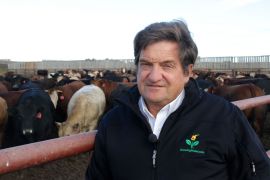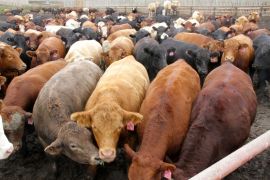
Alberta is known for its beef — or more specifically, its beef marketing. Even if you haven’t seen the original “I heart Alberta beef” bumper sticker, you’ve definitely seen an homage.
But Alberta beef started for a reason. Alberta’s grain farmers needed a way to diversify and add value to their product. Grain prices are notoriously volatile and producing a bumper crop didn’t always guarantee a bumper profit.
Bern Kotelko grew up farming near Vegreville, near Edmonton. After finishing a degree at the University of Alberta he came back to the family farm and saw where the farming world was going. He and his brother opened their own feedlot and started fattening up cows with grain. When you start having that many cows in one place the poop starts to pile up. Rather than see that as a problem, Kotelko and his business partners saw it as an opportunity.
“Some people call it waste but we’ve gotten past that, where we don’t have to use the “W” word here. It all has value — it just needs to be utilized in a different form,” says Kotelko.
That different form comes in the shape of an anaerobic digester. This takes their cow manure plus green bin organics from nearby communities and turn it into methane (biogas). That methane is burned in a 2.5-megawatt electricity generator, which produces enough electricity for 2,500 homes.
 Their 36,000 head feedlot produces 500 tonnes of manure a day. They also accept 200 tonnes of organic waste from nearby municipalities. As a bonus they get a tipping fee for taking the organic waste, which has three times as much energy per shovelful as manure.
Their 36,000 head feedlot produces 500 tonnes of manure a day. They also accept 200 tonnes of organic waste from nearby municipalities. As a bonus they get a tipping fee for taking the organic waste, which has three times as much energy per shovelful as manure.
But the electric generators produced a new waste product — a ton of extra heat.
“So we did some research on fuel-grade ethanol and it turns out it is a huge user of energy in the form of heat in the fermenters and the distillation process. And so our next step was to add an ethanol plant that produced fuel-grade ethanol and used the surplus heat off the generators,” says Kotelko.
All of this together is called Growing Power Hairy Hill. This tripod of interconnected businesses creates a virtuous cycle. The waste from one becomes the input for another. In fact, the on-site activity can get a little dizzying. Thankfully we have Trever Nickel around to help navigate this maze. He’s the general manager of Himark Biogas, a company that designs and licenses the biogas technology in use at the plant.
He walked us through all the inputs and outputs.
- Feedlot: Produces beef and manure. Uses leftover wet distiller's grains from ethanol plant to feed cattle.
- Anaerobic Digester and Generators: Produces biogas, electricity, heat and fertilizer. Uses manure as a feedstock as well as municipal organic waste.
- Ethanol Plant: Produces ethanol and wet distiller's grains. Uses waste heat from the generators.
“They all work together,” says Nickel. “That’s why we call it an integrated bio-refinery. But it’s the digester acting as a micro-utility that unleashes the power of the integration.” A graphic from their website shows how it all works.
Unfortunately, even with Alberta’s giant cattle herd of 4.99 million animals there is only one other anaerobic digester in the province. Alberta’s two ethanol plants produce only 80 million litres of ethanol, a fraction of the 265 million litres required by Alberta’s mandated use of fuel-grade ethanol. This is ironic for an energy-focused province with such a surplus of grain.
Investors and banks don’t know what to make of these set-ups, and without clear signals from government that these types of projects are wanted, they haven’t taken off. In contrast, by offering a modest feed-in-tariff to producers, Germany has built 5,000 digestors. With a change in Alberta’s carbon pricing scheme or simply a change that recognizes the value that these facilities produce, Nickel sees a huge opportunity for biogas in this province.
Raising Alberta's very modest carbon fee to $35 or more per tonne would shift the economics to support 10 to 20 more biomass/ethanol facilities the same size as theirs, says Nickel. He also sees room for more than a hundred smaller-scale generators, producting 0.5 to 1 megawatt each.
“That would take so much of our waste right off the map, produce renewable energy and clean up the environment to boot,” he says.
Of course he’s in the business of selling the technology behind these biogas generators — but with the amount of cattle in Alberta, the opportunity for farm diversification and energy production is considerable.
Bern Kotelko invokes the sentiments of his grandfather on the future. “I think we’re going back to where our grandfather taught us on how to be sustainable and think of the future — how are we going to do that for not just tens of years ahead but thousands of years ahead? We’ll always have biomass where we have civilization, and if we utilize our biomass properly we’ll be able to be self sufficient in food and energy at the same time.”
David was the host and producer of the Green Energy Futures multimedia series.
Duncan was the editor and production manager of Green Energy Futures until 2015.




